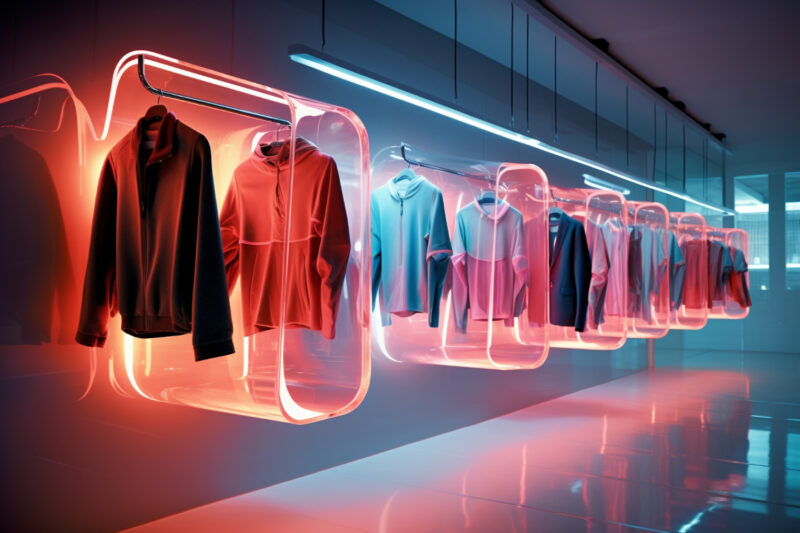Executive Summary:
We’re all tired of visiting malls and trying on numerous clothes for that perfect outfit. But what if there was a way to end that tiring cycle and get a hassle-free and efficient solution for all shoppers? Yes, we are talking about AI virtual fitting room technology
It’s a creative and genius solution for all our shopping-related problems because, with these virtual rooms, a shopper gets to try on outfits from the comfort of their couch. There is no need for them to go to shopping malls and use the overcrowded changing rooms.
Virtual fitting rooms work with augmented reality (AR) and virtual reality (VR) technology operated by AI and 3D modeling. It visualizes how the clothes look on your body in perfect detail.
By simply using a smartphone or webcam, shoppers can create a digital avatar (either through detailed measurements or a quick body scan) and virtually “try on” garments from various brands and styles.
In this blog, we’ll talk about the need for virtual fitting rooms and explain how to develop a AI virtual fitting solution for an easy shopping experience.
AI virtual fitting room technology offers advanced solutions by enabling customers to wear clothes virtually using digital devices. The use of AI in this technology enhances the online shopping experience by providing a more accurate feel for how clothes might look on a person’s body without them having to physically try anything on.
Why Develop a Virtual Fitting Room Technology Using AI?
The emergence of virtual fitting rooms and the integration of AI technology signify a groundbreaking shift in how customers interact with the fashion and retail industries.
These innovative apparel solutions promise to improve the shopping experience by saving time and lowering returns. Here’s why you need to incorporate virtual fitting solutions:
- Improve the Shopping Experience
The use of AI has changed the way virtual fitting rooms operate. It redefines how consumers shop. Because of this, retailers can now provide customers with an unsurpassed level of personalization and ease. This saves time and reduces the physical effort of trying on different clothes.
- Increase Efficiency and Reduce Returns
Customers try clothes based on size, but sizing differences between brands and styles can produce unpleasant inconsistencies. To address this issue head-on, apparel detection solutions come to the rescue.
These technologies precisely determine the customer’s body dimensions and measurements using AI, eliminating all space for speculation or confusion.
- Use Data-Driven Perspectives
AI technology uses customer data and feedback to generate insights into their preferences. It can help retailers understand consumer behavior and make informed decisions about stock, sales, and marketing strategies.
Overall, virtual fitting room technology powered by AI provides numerous benefits for customers and retailers in fashion and retail.
How Virtual Fitting Room Technology Works?
Virtual fitting room technology is designed to function with advanced 3D body modeling. It uses depth sensors and camera scans to create a digital doppelganger representing a unique body shape. Then, this avatar becomes a virtual stand-in and is ready to try on countless outfits.
But since this is about clothes that need to fit for a shopper to purchase, 3D garment modeling also comes into play. With its high-resolution scans and specialized software, it meticulously captures the intricacies of each garment, which helps get the idea of fabric textures and embellishments.
These digital clothes are then overlaid onto an avatar, creating a lifelike representation of how the outfit would look on a person. It will understand the posture, pose, and even subtle nuances of a person, like shoulder shrugs or bent knees.
This brings a seamless and personalized shopping experience where anyone can try outfits, visualize fit and drape, and even mix and match styles, all from the comfort of their home.
Types of AI Virtual Fitting Rooms Technology
Some virtual fitting solutions use form-fitting algorithms to create accurate models of customers’ bodies, while others use image-recognition algorithms to recognize objects within a picture and detect what a person looks like. The types of AI virtual fitting rooms are:
- Body Sizing Solutions
These rooms use AI and machine learning to estimate body measurements from photos or scans. It helps the shopper choose the right size for clothes online, reducing returns and improving satisfaction.
- In-Store Virtual Dressing Solutions
Also known as “smart mirrors,” these rooms are installed in physical stores and use cameras and sensors to create a virtual overlay of clothes on a body. Shoppers can see how different outfits look on them without physically trying them on.
- Online Virtual Room Solutions
These are typically accessed through websites or mobile apps. One can upload a photo of themselves or use a pre-made avatar and then try on virtual versions of clothes from different brands.
- Wardrobe Assistants and Outfit Planners
These assistants help a person create outfits from clothes they already own. We can upload photos of our wardrobe or use pre-made clothing items, and the AI will suggest different combinations based on our style preferences.
Dress to Impress With a Virtual Fitting Room Technology
Bid farewell to endless clothing racks and uncertain lighting. Now, shoppers can envision a perfect outfit from the comfort of their couch by observing how elegantly it drapes over their bodies. Here’s what you can offer with a virtual fitting room:
- Customized Suggestions & Guaranteed Fit
We all rely on someone to give suggestions on clothes and often turn to our friends or family for advice. However, the virtual fitting room can act as a style guide now, as it knows your individual style preferences, body measurements, and past purchases to recommend clothing items that perfectly align with your taste.
- Saving Time & Effort
Time and effort are both valuable when it comes to shopping for clothes on busy days. With virtual fitting rooms, shoppers can save significant time and effort by virtually trying on clothes without any physical labor.
Whether you’re dressing for a casual day out or a formal event, virtual fitting rooms provide curated ensembles that consider color palettes, patterns, and styles, making coordination a breeze.
- Virtual Styling Experience
There’s no need for a shopper to hassle by going to every shop, searching for one top. AI offers recommendations tailored to unique preferences. It means one can experiment with different looks, discover new styles, and find the perfect outfits for any occasion.
- Body Sizing Solutions
Virtual fitting room makes the process of finding your perfect size quick and easy. With accurate body measurements, shoppers can say goodbye to incorrect-size purchases and avoid the hassle of returns. It helps them feel confident in their choices and ensures a seamless shopping process.
How to Build the Perfect Body Measurement App
Creating a virtual fitting room app entails a comprehensive process that requires planning, design, development, and testing.
The workflow may vary depending on the chosen product type and desired features. However, focusing on technical aspects, such apps enable users to try on clothes virtually and obtain accurate body measurements.
Here’s an overview of how a body measurement app functions:
- Users capture a photo or video of themselves in a predefined pose and provide additional characteristics like height and prominent body features.
- The app uses machine learning models to detect key body points necessary for accurate sizing.
- Generative models are employed to match clothing items with the user’s body, generating additional body parts not obscured by clothes.
- Two main machine learning models are incorporated: A pose Estimation Model for identifying key body points and an Image Segmentation Model (Body Segmentation) for generating pixel masks of the human body.
- The accuracy of body measurements for different body parts may vary significantly, requiring continuous testing and refinement for optimal performance and user satisfaction.
Based on our experience, it’s necessary to remember that the accuracy of body measurements for different body parts varies widely. That’s where the machine learning models from point 4 come into play.
- Pose Estimation
Pose estimation is crucial for analyzing human position accurately, with options including 2D and 3D models. From our experience, 3D models offer higher accuracy by detecting body key points in coordinates (x, y, z), which is essential for virtual fitting room solutions.
- Body Segmentation
Body segmentation models are also used in the app to identify the body’s outline in photos provided by users. And it accurately separates pixels that belong to the body from those that don’t.
While this task is well-established and generally produces dependable outcomes, the difficulty arises when translating these pixel-based results into real-world measurements.
This conversion process usually relies on factors like the user’s height to ensure accurate and meaningful measurements.
AI Calculating Measurements
The final step involves creating a pipeline based on the models’ results to calculate the required body measurements.
Challenges that may occur in this step are camera angle for accuracy due to overlapping body parts and background color similarity to clothing. It can happen that measurements may not calculated correctly.
To mitigate risks, users should be in a well-lit environment, distinguishable from the background. Moreover, the quality of measurements may depend on the phone camera quality, and different users may measure differently.
Here is a table for customers to understand how body measurements are calculated:
| Body Part | Complexity Level | Factors Affecting Accuracy |
|---|---|---|
| Height | Low | User-reported height and photo analysis generally provide good accuracy. |
| Shoulders | Medium | Accuracy depends on clothing complexity (e.g., loose vs. fitted), arm position, and posture. |
| Chest | Medium | Tight-fitting clothing improves accuracy, but posture and breast size can influence results. |
| Waist | Medium | Posture, clothing folds, and individual body shapes can affect accuracy. |
| Hips | Medium | Similar accuracy limitations as waist measurements are influenced by posture and clothing. |
| Arms | High | Accuracy is impacted by arm position, clothing coverage, and pose. |
| Inseam | High | Requires full-body photo and specific pose for precise measurement. |
How to Develop an App With 3D Models
Another approach to developing a body measurement app can be an app with 3D models and virtual fitting room technology. These models can simulate body shape and size, allowing for a more accurate virtual try-on experience. Some steps include.
1. Concept & Design
Clearly define your app’s purpose, target audience, and core features. Design user-friendly interfaces for interaction and data visualization.
2. 3D Modeling
Create high-quality, realistic 3D models of clothing and environments, considering texture, lighting, and animation for a seamless experience.
3. Engine & Development
Choose a suitable game engine or development platform with tools for rendering 3D graphics, physics simulation, and user interaction. Develop core functionalities like character customization, virtual try-on, and animation systems.
4. Integration & Testing
Integrate 3D models with your chosen platform, ensuring smooth performance and compatibility. Rigorously test across various devices and scenarios for optimal user experience.
5. Launch & Feedback
Prepare for app store submission, marketing strategies, and ongoing user feedback collection. Continuously analyze and iterate based on user needs and performance metrics.
How to Develop an App With Latent Diffusions
One more method, which is a technical approach for virtual fitting room development, involves latent diffusion and its variations. Here’s how it works:
We implement a stable diffusion inpainting pipeline tailored to custom clothes. Setting up the model requires over 50 pictures of clothes from different angles, along with clothes masks and text descriptions.
During development, the dataset with clothes pictures undergoes preprocessing to obtain masks and text descriptions. The model setup involves establishing connections between pieces of clothing and their corresponding text descriptions.
The input interface includes:
- A base picture for clothing changes.
- A mask indicates where the clothing change occurs.
- A text description specifying the desired clothing to be added.
The choice of technical approach typically hinges on your objectives, available resources, and constraints, as each virtual fitting room product is distinct and necessitates a tailored approach.
How Folio3 AI Helps With Virtual Fitting Room Technology
At Folio3 AI, we specialize in developing customized virtual fitting room solutions using advanced AI and 3D modeling techniques. Our team of experts has extensive experience in developing successful and scalable AI-powered applications for the AI fashion industry.
We work closely with clients like you to get a better idea of your unique requirements and develop tailored solutions that align with your goals. With a deep understanding of machine learning models, generative models, and AI technologies, we can deliver highly accurate and seamless virtual fitting room experiences for our clients.
We aim to help fashion businesses enhance their online shopping experience, reduce customer returns, and increase customer satisfaction by implementing Folio3 AI solutions.
Conclusion
Virtual fitting rooms have indeed reshaped the fashion industry by providing a more accurate and convenient way for customers to try on clothes virtually. By using various techniques like pose estimation, segmentation, and 3D modeling, these solutions can provide a realistic and personalized experience for users.
With the advancement of AI technologies and the expertise of companies like Folio3 AI, virtual fitting rooms will continue to improve and become an essential tool for fashion businesses.
Contact us today and take your online shopping experience to the next level with a custom virtual fitting room solution!
You May Also Like To Learn About:
Real-Time Cloth Detection: Applications In Smart Homes
Clothing Detection For Virtual Clothes Try On – A Seamless Shopping Experience
Revolutionizing Fashion Retail: How Clothing Detection Enhances Customer Experience
How To Find Clothing By Picture

Dawood is a digital marketing pro and AI/ML enthusiast. His blogs on Folio3 AI are a blend of marketing and tech brilliance. Dawood’s knack for making AI engaging for users sets his content apart, offering a unique and insightful take on the dynamic intersection of marketing and cutting-edge technology.










